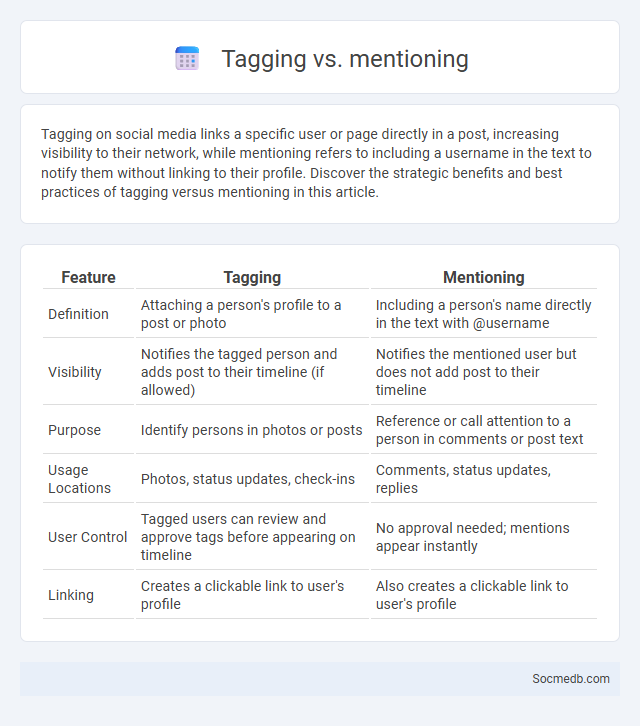
Photo illustration: Tagging vs Mentioning
Tagging on social media links a specific user or page directly in a post, increasing visibility to their network, while mentioning refers to including a username in the text to notify them without linking to their profile. Discover the strategic benefits and best practices of tagging versus mentioning in this article.
Table of Comparison
| Feature | Tagging | Mentioning |
|---|---|---|
| Definition | Attaching a person's profile to a post or photo | Including a person's name directly in the text with @username |
| Visibility | Notifies the tagged person and adds post to their timeline (if allowed) | Notifies the mentioned user but does not add post to their timeline |
| Purpose | Identify persons in photos or posts | Reference or call attention to a person in comments or post text |
| Usage Locations | Photos, status updates, check-ins | Comments, status updates, replies |
| User Control | Tagged users can review and approve tags before appearing on timeline | No approval needed; mentions appear instantly |
| Linking | Creates a clickable link to user's profile | Also creates a clickable link to user's profile |
Introduction to Tagging, Mentioning, and Labeling
Tagging, mentioning, and labeling on social media platforms enable precise user interaction and content categorization, enhancing visibility and engagement. Tagging often connects content to specific users or topics, while mentioning directly notifies individuals, driving communication and network growth. Labeling organizes posts with relevant keywords or categories, facilitating searchability and improving content discovery algorithms.
What Is Tagging?
Tagging on social media involves linking a person, page, or topic within a post, photo, or comment to make content easily discoverable and notify the tagged entity. This feature helps increase engagement by connecting your content to relevant profiles or subjects, boosting visibility and interaction. You can use tagging to highlight friends, brands, or interests, enhancing both personal and professional networking opportunities.
What Does Mentioning Mean?
Mentioning on social media refers to the act of tagging or directly referencing another user by including their username or handle within a post or comment. This feature facilitates communication, increases visibility, and helps users engage with specific individuals or groups by notifying them of the mention. Popular platforms like Twitter, Instagram, and Facebook utilize mentions to foster interaction and build connections among their user communities.
Tagging vs Mentioning: Key Differences
Tagging in social media involves linking a user directly to a specific post or photo, making the content easily discoverable on that user's profile, while mentioning uses the '@' symbol to reference a user within a comment or caption without creating a direct link on their profile. Tagging often notifies the tagged user and associates them publicly with the content, enhancing visibility and engagement through shared content. Mentioning primarily serves to draw attention or credit to a user in conversations, fostering interaction but with less permanence on the mentioned user's profile.
Benefits of Tagging in Social Media
Tagging on social media enhances content visibility by connecting posts to relevant users and topics, increasing engagement rates up to 50%. It fosters community interaction by directly involving tagged individuals or brands, boosting social recognition and follower growth. Effective tagging also aids in content discoverability through platform algorithms, driving targeted traffic and expanding audience reach.
Advantages of Mentioning in Online Platforms
Mentioning individuals or brands in social media posts increases visibility and fosters engagement by directly notifying the tagged party, encouraging interaction. Your online presence benefits from amplified reach and the potential to build stronger relationships through targeted acknowledgments. This strategic use of mentions enhances network connections, driving traffic and boosting brand awareness effectively.
Tagging and Mentioning: Best Practices
Tagging and mentioning on social media enhance user engagement by directly connecting content with relevant individuals, brands, or topics, thereby increasing visibility and interaction rates. Best practices include using accurate and relevant tags to avoid spammy impressions, respecting privacy by seeking permission before tagging individuals, and strategically mentioning influencers or collaborators to foster authentic relationships and expand reach. Consistent monitoring of tagged content helps maintain brand reputation and facilitates timely responses to audience feedback or inquiries.
Common Mistakes in Tagging and Mentioning
Incorrect tagging and mentioning on social media can diminish your content's reach and engagement by misdirecting notifications or irritating users. Over-tagging or irrelevant mentions often lead to reduced credibility and can trigger algorithm penalties, decreasing visibility. Ensuring precise and relevant tags enhances audience targeting and fosters genuine interaction with your followers.
Tagging vs Mentioning: Use Cases and Examples
Tagging on social media involves directly linking a user's profile to content, making it visible to their network and often used for identifying people in photos or collaborative posts. Mentioning uses the "@" symbol to reference users within captions or comments, driving conversations or calling attention without necessarily linking to the content. Brands leverage tagging for product endorsements and partnerships, while mentions engage users in discussions and highlight contributions.
Conclusion: Choosing the Right Approach
Selecting the right social media strategy involves analyzing your target audience, business goals, and platform strengths to maximize engagement and ROI. Tailoring content to fit each channel's unique features ensures your message resonates effectively with users. Your success depends on continuous evaluation and adaptation to evolving trends and user behaviors.
 socmedb.com
socmedb.com